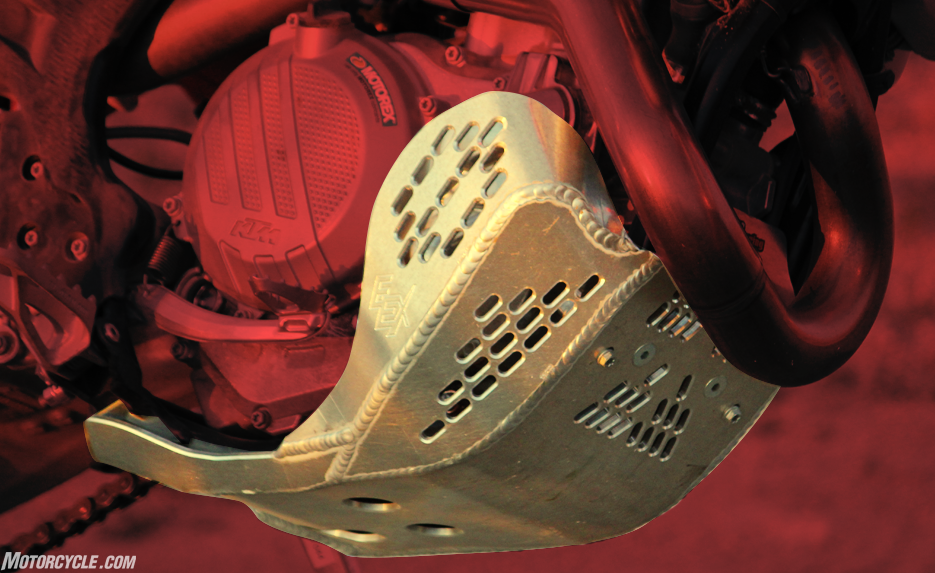
I guess manufacturers know that you’re going to swap on aftermarket parts from the get go, but it doesn’t make it any less annoying that machines like KTM’s 500 EXC-F, which retails for $12,549, don’t come with even the most basic engine protection. In the rocky terrain I find myself riding in the western U.S., a skid plate is an essential worker. But that’s not the only bit of protection I like to get my machines outfitted with before hitting the trail. We already mentioned the purchase price of a new pumpkin, so spending a few more dollars to protect components before they have the chance to get smashed seems like a worthwhile investment.
Essential Dirt Bike Upgrades For Essential Recreation Part 2 – Making the Mileage
For me, and the type of riding I like to do with a dual-sport bike (almost no pavement with plenty of technical riding), a skid plate, rear disc guard, wrap-around handguards, and radiator guards pretty much sets up a new bike for withstanding some serious abuse. Thankfully, there is a company making all of that here in the States that I’ve relied on to protect my dirt bikes for years now: Enduro Engineering.
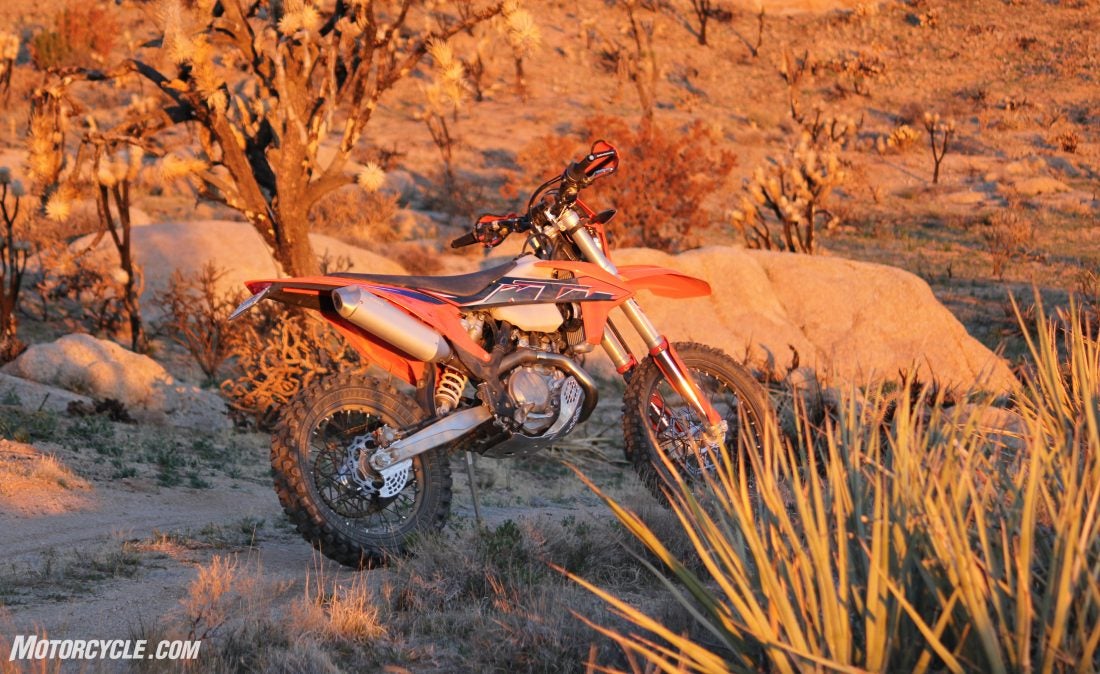
Based in a small Michigan city with a population less than 10,000, Enduro Engineering has been headed up by owner Alan Randt since the late 80’s. Alan’s name may sound familiar to those in off-road racing circles, not only because of his own accomplishments in racing, but also because he now heads up the NEPG-AMA National Enduro series. Randt bought the fledgling Enduro Engineering in 1984 and kept it going while continuing to race and run a dealership. In the 90’s things ramped up significantly for Enduro Engineering as it began making products for the likes of Moose Racing and MSR while doubling down in development and production of its own products as well.
Today, Enduro Engineering offers a myriad of components for protecting enduro riders’ machines, parts to make them work better, a carefully curated selection of parts from other brands, and even suspension services for those looking to have their setup refined. EE offers something for everyone, from the casual trail rider, to sponsoring the Factory Beta USA team and supporting hundreds of other racers throughout the years.
With all that said, Enduro Engineering is a brand I’ve relied on to protect my machines from myself for many years, and with the significant racing history to help them develop components, I feel confident in recommending their product. Let’s have a look at what I’d consider some essential protection to install before getting started down the trail.
Enduro Engineering Extreme Skidplate
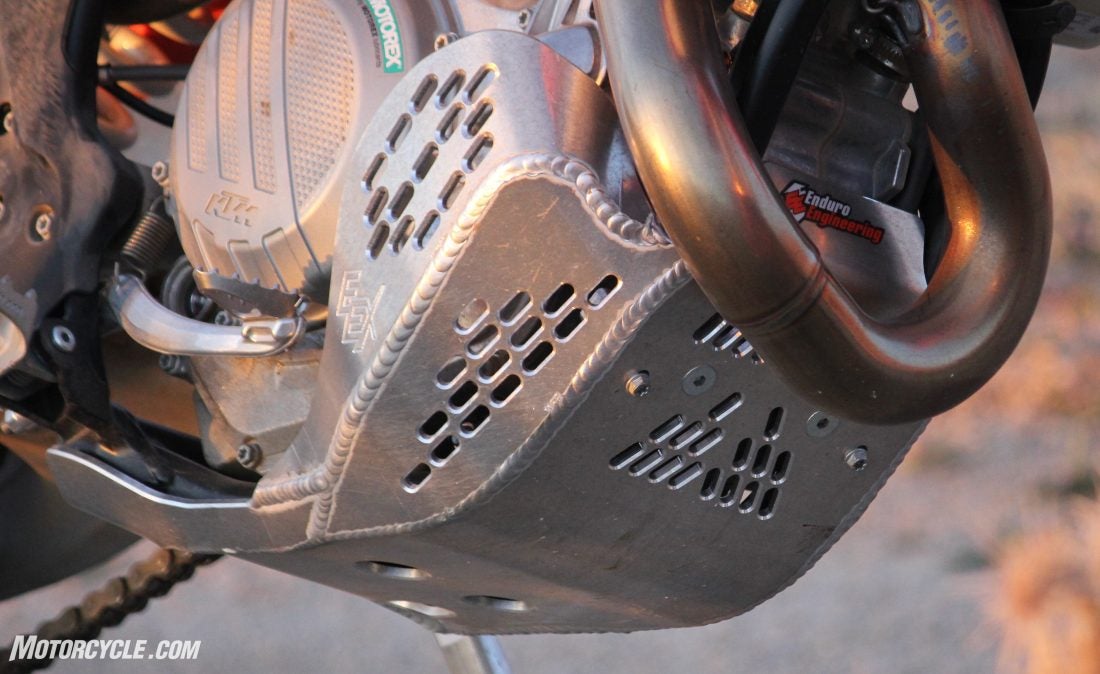
Enduro Engineering’s Extreme Skidplate is available for KTM, Husqvarna, GasGas, Beta, and Sherco motorcycles. This covers everything from motocross bikes to off-road racing machines, and plated dual-sports. The company’s standard skidplate, which doesn’t wrap quite as far up around the motor, can be had for many other brands including Honda, Kawasaki, Suzuki, and Yamaha as well as the aforementioned OEMs.
As mentioned previously, the Extreme skidplate is based on EE’s standard skidplate, the only difference being the additional “wings” that come up higher on each side to better protect the engine. The aluminum design covers the frame rails and is angled slightly on the outer edge of the rails to protect footpeg mounts and give you a better chance of glancing off of obstacles.
As you can also see in some of the photos, EE includes cut-outs for accessing drain plugs for oil changes, but on the Extreme version, it’s going to be kind of a pain (if it’s possible at all, I haven’t tried) to replace the oil filter. So, it’s more likely that you’ll need to drop the skidplate for oil changes. The standard plate shouldn’t have any issue staying put during oil changes. For me, I’d rather have the extra protection, and since the skidplate is easy to remove and reinstall, I’m fine with doing it. Plus, I always tend to make more of a mess with my oil changes than I mean to.
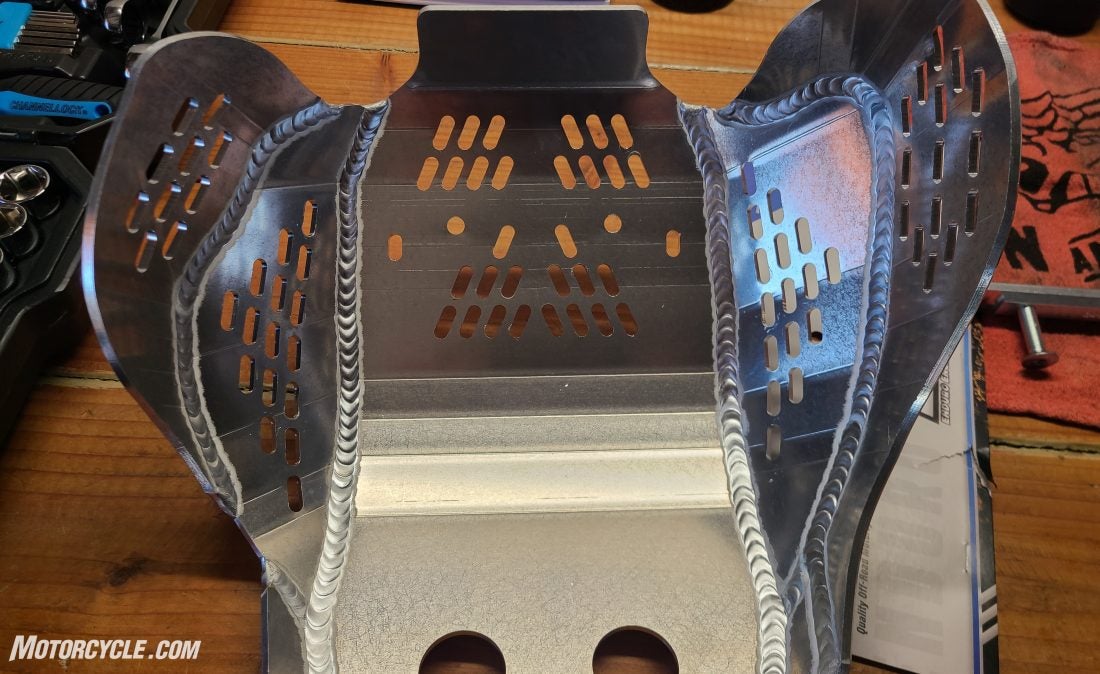
Installation is simple with a hook in the rear securing the back of the skidplate to the frame’s crossmember and two bolts up front securing the plate to the frame. Before you mount up the skidplate, EE provides a long strip of adhesive backed foam to run along the frame rails where the skidplate covers. This ensures you won’t have any metal on metal rattling should you take a hit hard enough to cause the metal to touch. The front of the plate can be secured with the supplied crossmember fitting on the back side of the upper frame rails. The EXC line has pre-drilled and tapped holes that you’re able to use the supplied longer bolts for. I used both. And it’s definitely not because I put it all together before realizing it was one or the other…
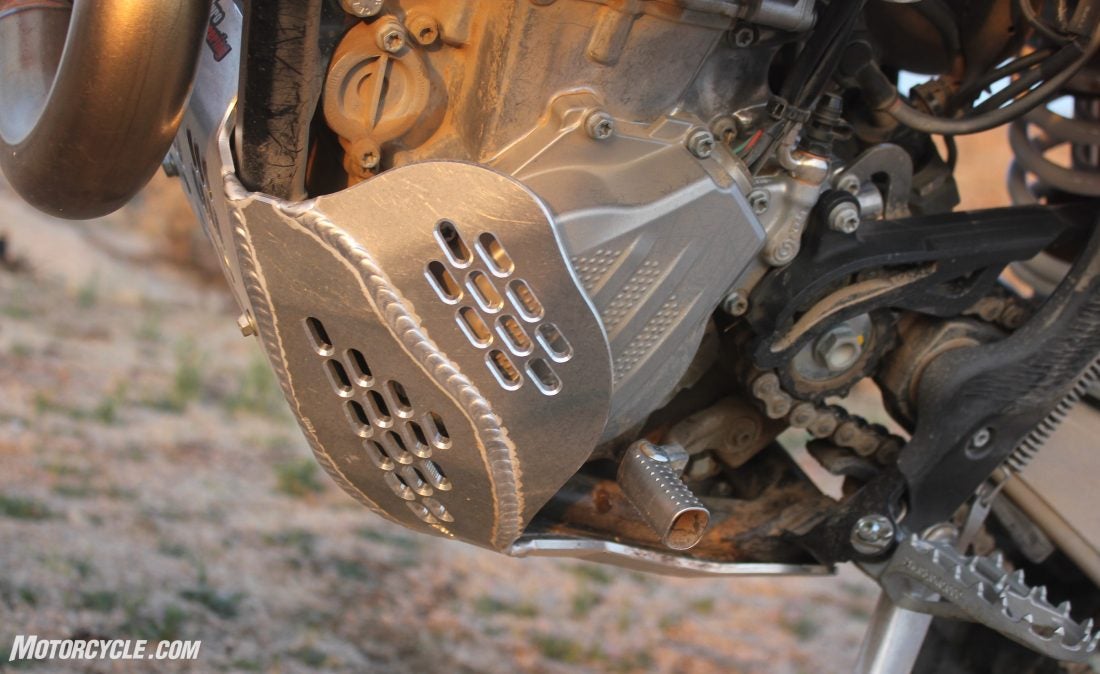
Overall, I really like the extra protection that the Extreme model gives, particularly because I use my dual-sports primarily for long trips that can have some fairly technical riding interspersed in the middle of BFE – the last place you want to have an issue. Given my experience (see: abuse) with other Enduro Engineering skidplates, I have no reason to think this won’t continue to offer protection for many thousands of miles.
Shop for the Enduro Engineering Extreme Skidplate here
Enduro Engineering Evolution 2 Handguards
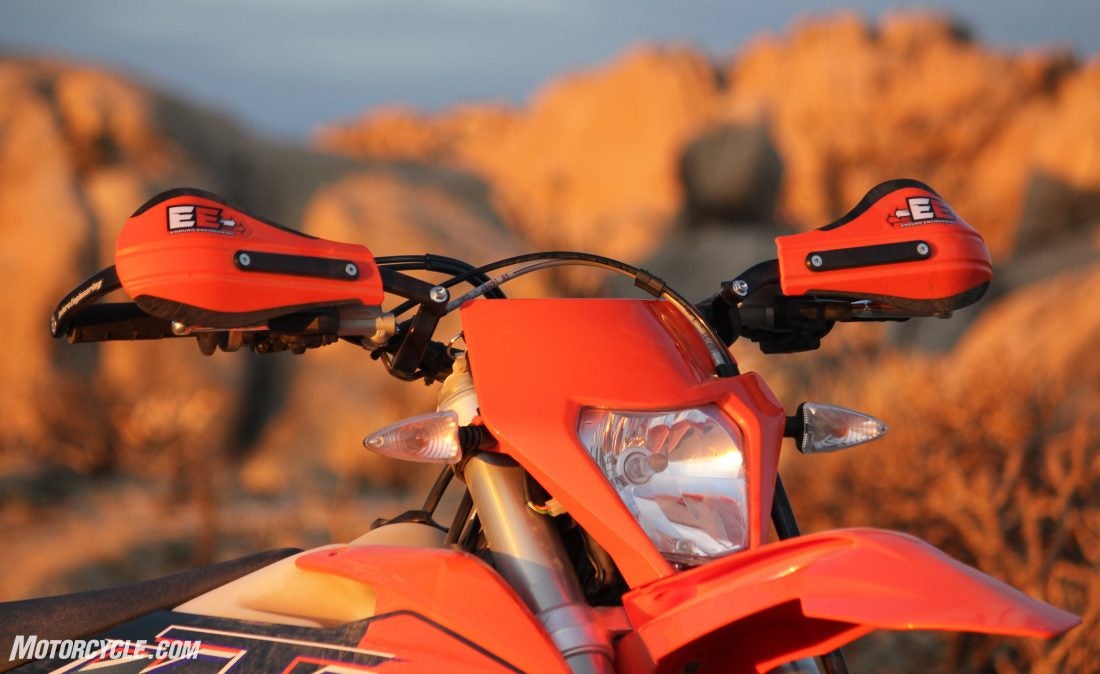
Handguards are like buttholes, everyone’s got one…er, wait.. Opinions, those are like buttholes. Whatever the case, I prefer wrap-around style handguards. That’s probably because it wasn’t that long ago that I was falling over a lot, and now, well, I still fall over, just not quite as much. In the process of learning how to stay vertical, I lost a handful of levers. While I have still managed to break levers with wrap around style handguards, most were with the “flag” type that are only connected to the handlebar on the inboard side.
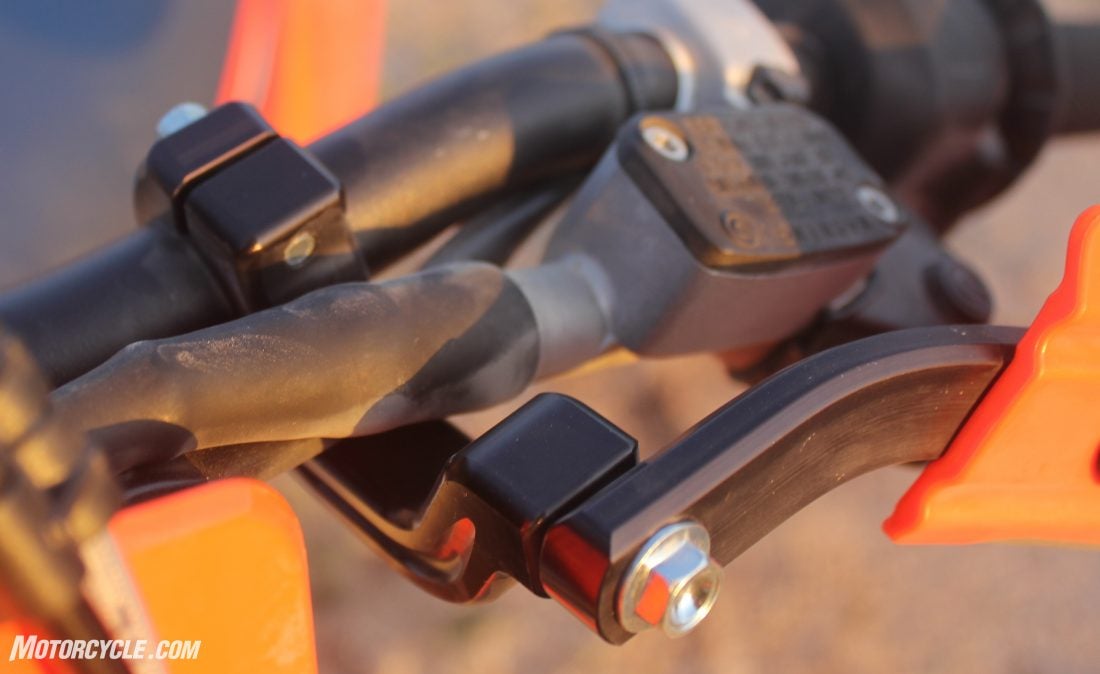
Enduro Engineering’s Evolution 2 debris deflectors consist of a fairly basic aluminum bar that attaches at the end of the grip (the grip and throttle tube must be drilled/cut out) with a taper lock and then to the company’s specialized bar clamps toward the middle of the handlebar. The clamps themselves are manufactured to provide more room for master cylinders and lines to be routed over them. I’ve had experience with other brand’s bar clamps that have been difficult to set up because they did not offer the u-shape of EE’s clamps.
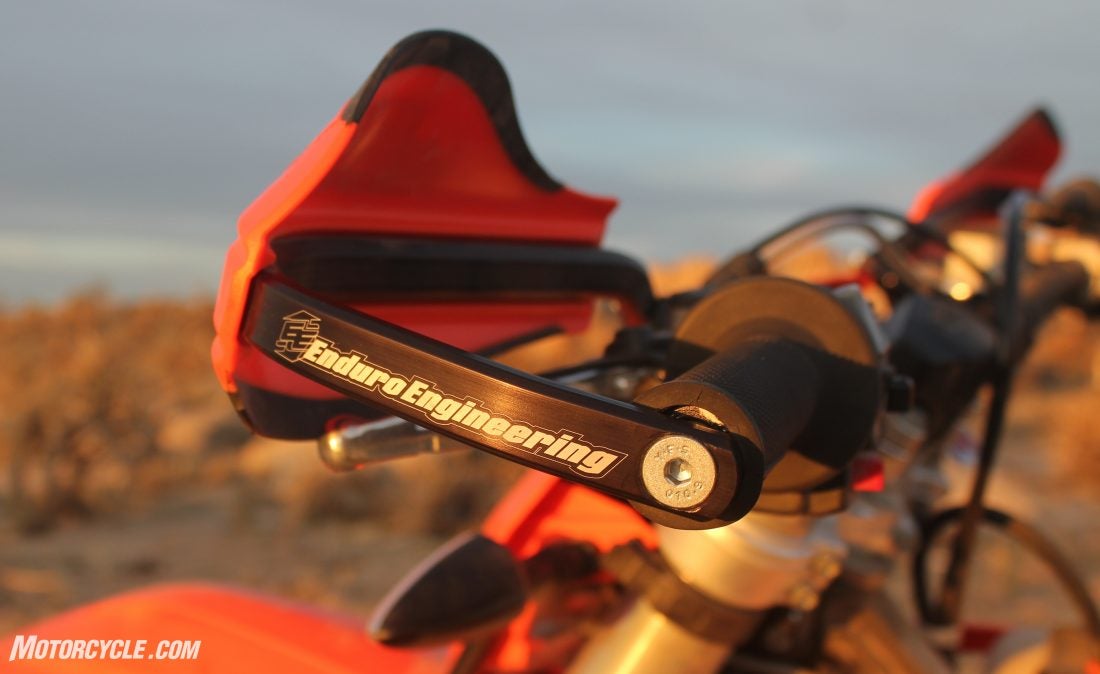
Again, install is as easy as it looks, drilling out the grips is probably the hardest part. Thanks to the KTM’s ODI grips that are made to easily have the ends punched out, even that was a straightforward job. If you want to look at the instructions, EE provides detailed ones with full color pictures and everything.
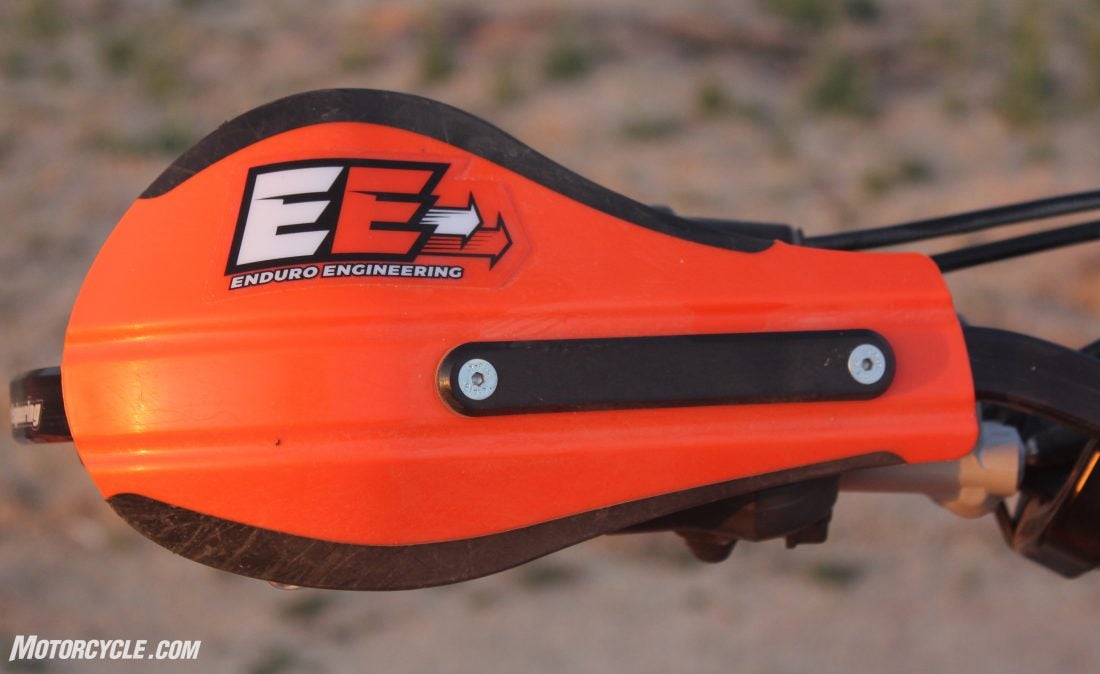
The plastic EVO2 deflectors are sold separately for $25 per pair and install easily with two bolts into the threaded holes in the aluminum bar. So, if you’ve got your deflectors all scuffed from learning how to not fall over, swapping in a new set will freshen up the look at a low price. Fitment of the Evolution 2 handguards is not model specific, as EE has clamps and taper locks to fit motorcycles with ⅞-inch or 1-⅛ inch handlebars.
Thankfully, I’ve managed to keep the bike upright so far while running the Evolution handguards from EE, but I’ll try harder next time we’re out.
Shop for the Enduro Engineering Evolution 2 Handguards here
Enduro Engineering Billet Radiator Guards

Ask ol’ Brascannons how easy it is to tip over and crack a radiator (on your coworker’s personal motorcycle). I’ve busted my fair share out in the rocky SoCal terrain. Whether toppling over, or simply smashing the lower portion on an ill placed rock, cracking your radiator is fairly easy. Heck, the one Brasfield managed to smash was supposed to be a “heavy-duty” racing type. [Sigh… – EB]
Although replacing a radiator isn’t terribly difficult, I’d rather not have to do it (even when my boss pays for the replacement). Swapping the OE plastic louvers for the Enduro Engineering guards is another easy process. EE’s website claims less than four minutes is needed for both sides. I spent a little longer than that because I wasn’t in a hurry, but not much. One point to note – something you should do with any install really – make sure to hand-tighten the bolts into the guards initially to prevent cross threading.
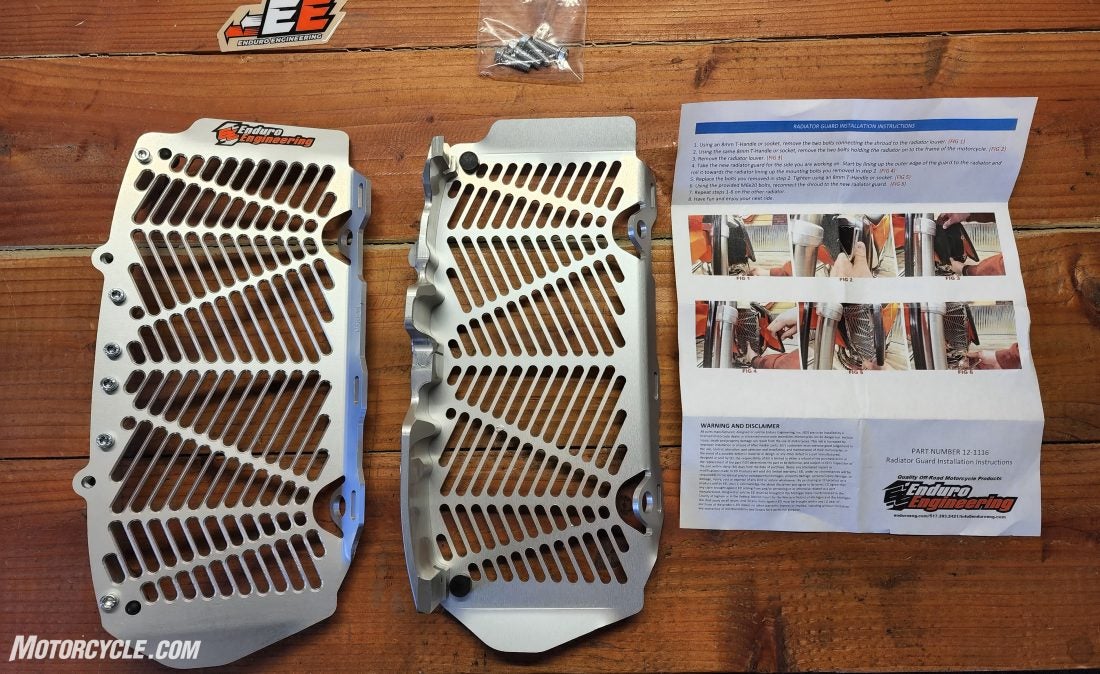
The Enduro Engineering billet radiator guards are somewhat new from the company and offer protection to the front, bottom (to an extent), and side, whereas a standard radiator brace only protects from side impacts. Thankfully, most of my riding is in the southwest where packing up with mud isn’t an issue, so I can’t speak to that potential, but blocking air is not something that I really want to do since I end up riding in fairly hot temps. It seems EE has done its best to balance protection and airflow. Fitment of this new style guard is available for select KTM/Husqvarna/GasGas, Beta, Sherco, and Yamaha models.
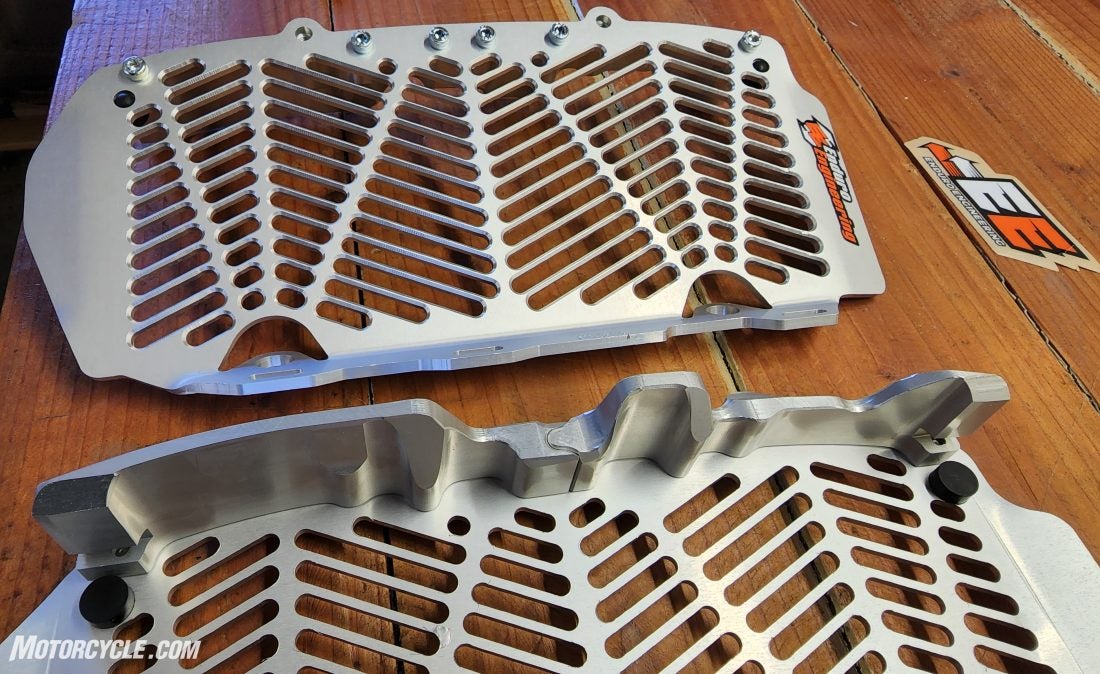
The guards are made of 3/16-inch aluminum with the sides measuring up to almost an inch at their thickest point and are built with a curve on the outer edge to allow for a bit of cushion should you have an impact hard enough to actually cause them to bend in. The nicely routed holes for airflow look good and match the skidplate and brake disc guard in design (if you care about such things). The front of the guard stays just over a half-inch from the front of the radiator and uses two rubber bumpers in the corner to damp noise should it manage to get bent in. The lower portion of the guard extends ¼-inch below the bottom of the radiator.
For those wondering if the guards cause the shrouds to stick out further, my guess is they may be protruding up to 1/16 of an inch further than stock, so it’s negligible.
There is one thing to note with the EXC-F model these were installed on. Because this is a street-legal motorcycle, it has a closed loop evaporative canister system to keep gas and its fumes within the motorcycle at all times. Two of the hoses for this system route between the frame and the radiator. When these guards are installed normally, it pinches those hoses pretty tight, almost to the point of clamping them off entirely (in my install). If you were to block airflow through those hoses completely, at the extreme end, you run the risk of collapsing or inflating your fuel tank. If air can still pass through, you will likely be fine, but routing them up and over has also been done, I’m told. Of course, if you’re some kind of criminal who plans to remove the evaporative system anyway, this doesn’t really matter.
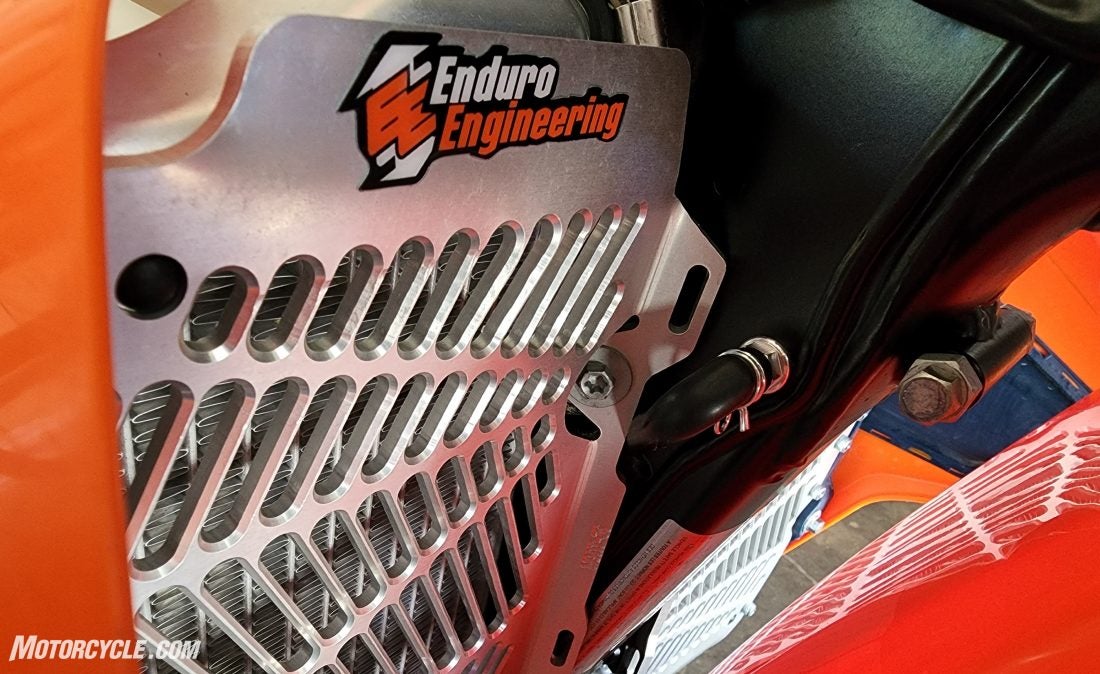
To put it bluntly, these guards are Stout. I hope that I don’t manage to destroy them, because there’s a good chance I’ll have destroyed myself in the process.
Shop for the Enduro Engineering Billet Radiator Guards here
Enduro Engineering Rear Disc Guard
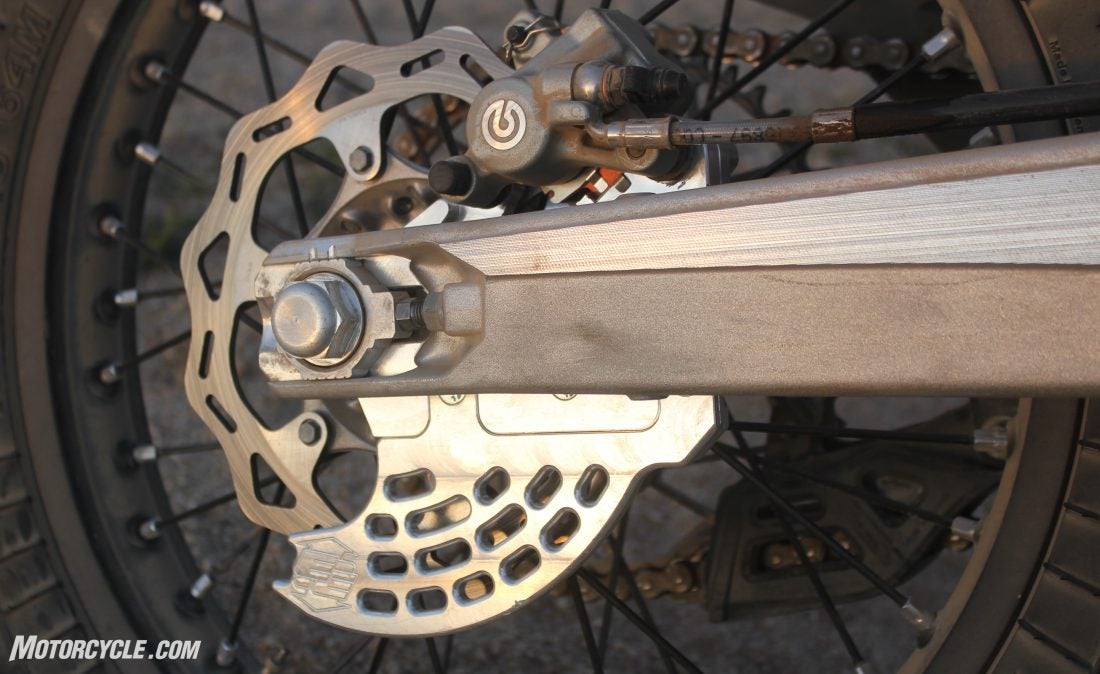
The rear disc guard is the only Enduro Engineering part here that I looked up a Youtube video to make sure I did everything correctly. Yes, they include instructions with color photography, but not only am I a man, I’m also a millennial. Turns out they made their own Youtube video of the installation too. Score! In the video, EE employee Logan walks you through the procedure on a Husqvarna (which could be interchanged with a GasGas or KTM with the same rear Brembo caliper). If everything included in this article was easy in terms of installation, the rear disc guard gets an easy +, meaning it takes a little more work and understanding than simply threading a bolt into a hole. Still, not a difficult thing to do.
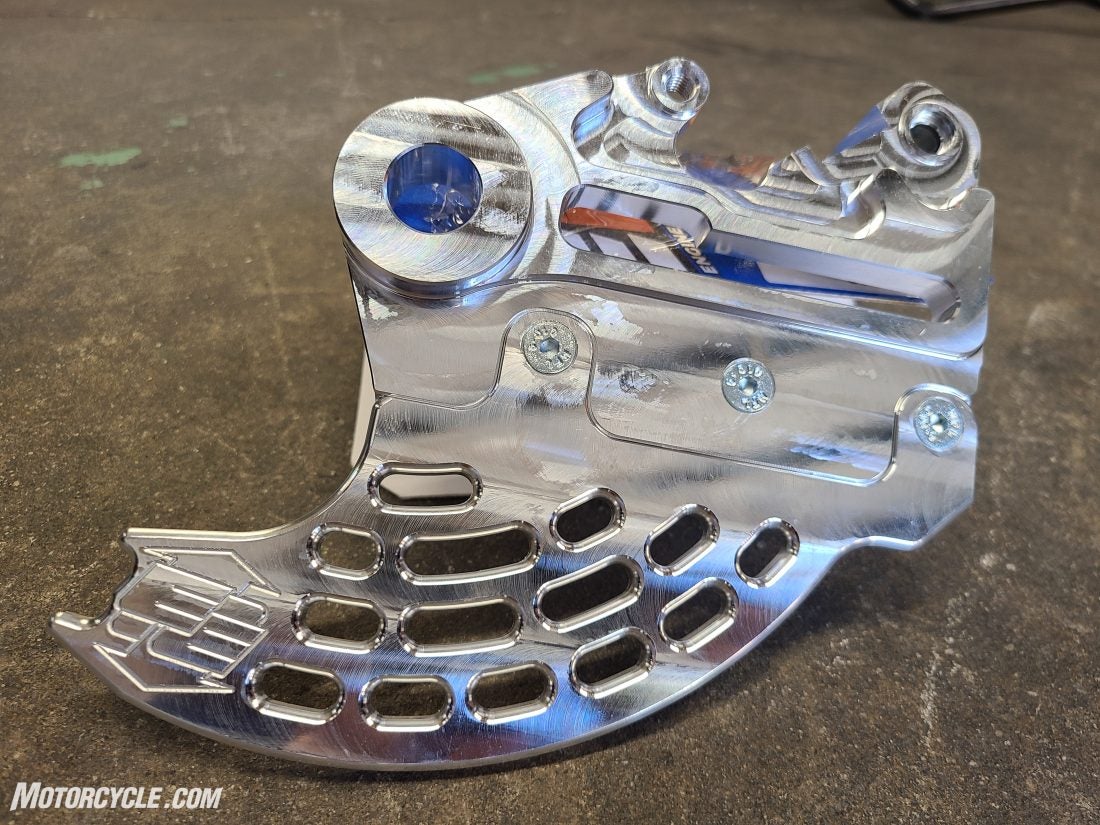
If you’ve changed your brake pads, you’ll be able to handle this. The EE unit replaces the entire OEM brake carrier with a shiny billet aluminum one that the protective fin is attached to (replacement fins can be purchased if you thrash the original). The fin itself is about ½-inch thick and extends past the leading edge and below the rotor by about ½-inch also.
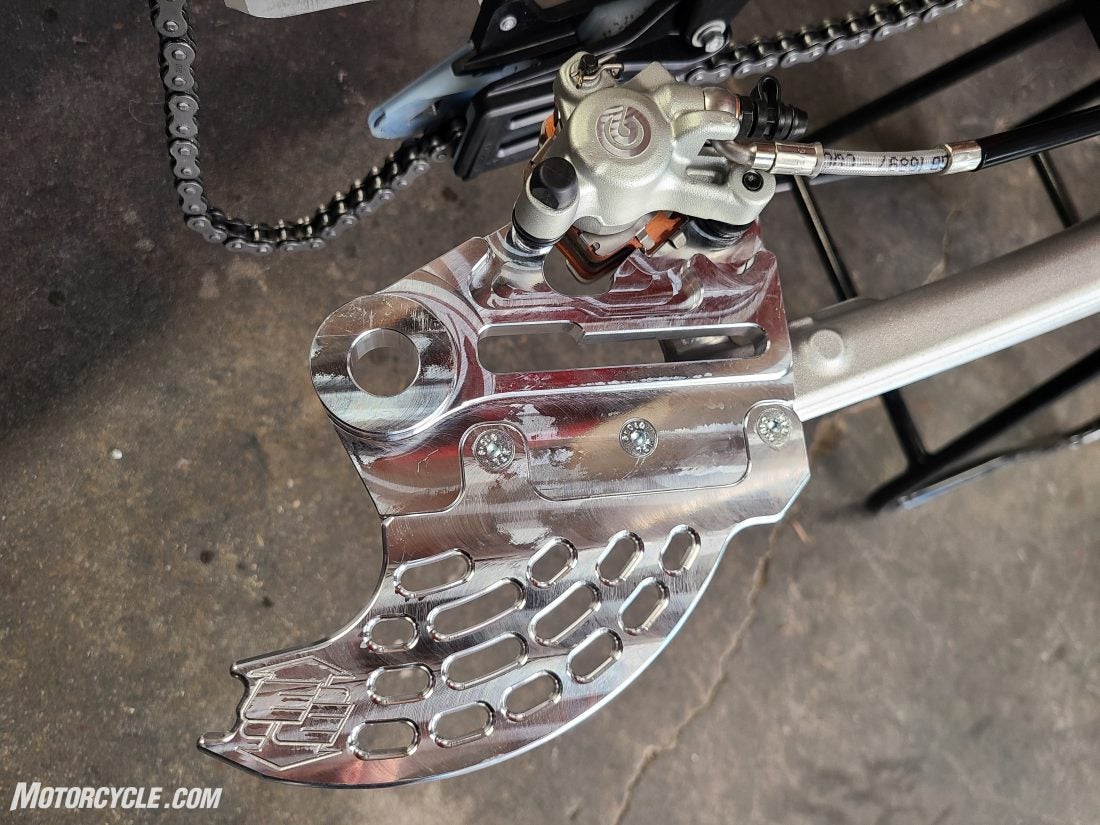
I opted only for the rear disc guard as it’s harder to keep track of while riding than the front, and keeping unsprung mass to a minimum on either wheel is typically the goal.
Shop for the Enduro Engineering Rear Disc Guard here
Conclusion
As you’ve probably put together by now, all of these protective bits are easy to install and offer loads more protection than any bike comes with off of the showroom floor. After spending thousands of dollars on a dirt bike or dual-sport, throwing $500 (retail price for everything included in this article is $516) at it in protection seems like a smart investment to me, as OEM parts are expensive and, these days, hard to come by. I waited to ride this 500 EXC-F until all of these parts were installed just to make sure I wouldn’t be kicking myself if something happened.
Check out the full line of goods at EnduroEng.com
The astute reader may have noticed that this article is the beginning of a series of ongoing stories where I share my choices and reasons for building out a dual-sport motorcycle the way I do, for the kind of riding I plan on using it for. Like a good cult leader, I’m not putting an end date or a cap as to how many of these there will be, but trust that I’ll be continuing to test these products for the duration and will update the articles with any failures or new found observations found on the trail. Stay tuned.
Additional Resources
- EZ ADV Upgrades: The Ever-Present Hunt For Traction
- EZ ADV Upgrades: In Darkness, Let There Be Light
- EZ ADV Upgrades: Helping The Katoom Breathe Freer And Cleaner
- EZ ADV Upgrades: Some Of The Cheapest Insurance You Can Buy
We are committed to finding, researching, and recommending the best products. We earn commissions from purchases you make using the retail links in our product reviews. Learn more about how this works.
 Your Privacy Choices
Your Privacy Choices